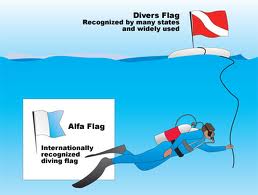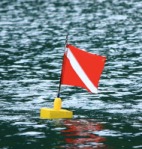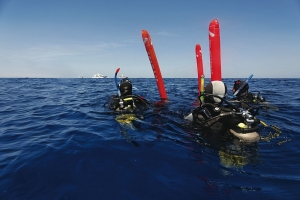
Most divers are familiar with the red and white “diver down” dive flag For many divers, the image of the diver down flag is a way to advertise their love of diving, but dive flags also fulfil a practical purpose.
What Is the Purpose of Flying a Dive Flag?
Dive flags are used to alert boats and other water craft that divers are in the area, possibly near the surface. The hope is that flying a dive flag will prevent accidental collisions between watercraft and scuba divers. Some commercially available dive flags are attached to floating surface support stations, such as an inflatable buoy or inner-tube. Dive flags also help surface support personnel track the location of submerged divers.
What Do Dive Flags Look Like?
Two main styles of dive flags exist:
The diver down flag and the alpha flag.
They have different applications, and the recommended use of dive flags varies with location.
The Diver Down Flag

The diver down flag is the well-known red flag bisected by a white, diagonal stripe. The stripe runs from the upper left corner of the flag to the lower right corner. This flag is used when divers are in the water to alert boats to the possibility of divers near the surface. In most locations, diver down flags should be lowered or removed from the water once the divers have safely exited the water. The flag is recognized in most parts of the world.
The Alpha Flag
The alpha flag is white and blue flag, with a triangular notch on the free end. The left side of the flag is white and the right side of the flag is blue. The alpha flag is recognized internationally and serves a different purpose from the diver down flag. The flag is flown by a boat whenever the mobility of the vessel is restricted. Other watercraft should recognize that the boat cannot move quickly, and should yield the right-of-way to a vessel flying an alpha flag. In the case of scuba diving, a dive boat must stay close to the divers it is tending, and cannot easily move from the vicinity of the people under the water. In many parts of the world, the alpha flag is recognized as an indication that divers are in the area, the flag has multiple uses and it is advisable to fly both the alpha flag and the diver down flag to avoid confusion.
When Should You Fly a Dive Flag?
Dive flags should be flown whenever there is the possibility of boat traffic at or near a dive site. When diving from a boat, a dive team need not carry its own dive flag provided that it stays within a predefined proximity of the dive boat.
When shore diving at sites where watercraft traffic is a possibility, divers should float their own dive flag on the surface, and stay close to the flag. The exact distance varies with location, but it is recommended that divers stay within 10 meters of the dive flag, depending upon the dive site.
How Close Can Boats Get to Your Dive Flag?
Boats and other water craft should stay well clear of dive flags, and should decrease their speed when approaching an area where a flag is visible. The exact distance varies with location. Realistically, however, boats can get just as close as they like to a dive flag. Distracted boaters might not even notice the flag, and some may not be aware of its meaning. Therefore, it is important to visually check the surface and listen for boat traffic before surfacing from a dive, even when a dive flag is properly used.
How Should a Diver Carry a Dive Flag?
In situations that require a diver to fly his own dive flag, the diver should tow the dive flag above him during the dive. Commercially available dive flags usually come with a buoy or inflatable raft to keep the flag upright at the surface. The diver tows the flag using a line attached to a reel. The reel should contain a length of line several times longer than the anticipated depth of the dive. Never clip the reel to your buoyancy compensator (BC) or dive gear when it is attached to a dive flag, because you risk becoming entangled in the line or dragged along behind a flag snagged by a boat. Divers who are using a dive flag should also carry a line cutting device in order to cut the line in the event of entanglement. Finally, all dive flags should be stiff enough to remain unfurled and visible without wind.
What Should You Do If You Have to Surface Far From Your Dive Flag?
In an ideal world, divers would always surface just underneath their dive flags or very close to the dive boat. However, it is possible that a diver may become disoriented or has an emergency, and have to surface away from the dive flag. For this reason, it is a good idea to carry an inflatable surface marker buoy at any dive site where there is the possibility of boat traffic. The buoy should be attached to a reel, and should be inflated and sent to the surface before the diver attempts to surface. A diver surfacing far from his dive flag or boat should always scan the surface of the water and listen for boat traffic before surfacing.

Related articles
- Brief Summary of Dive Banners (kamyabcard.com)
- Rescue diver: ‘It was like being in a washing machine’ (komonews.com)
- Red Sea trip photos: diving from a liveaboard (learntodivetoday.co.za)
- Please Take A Dive Flag! (southmauispearfishing.wordpress.com)